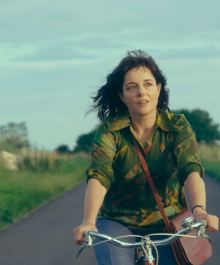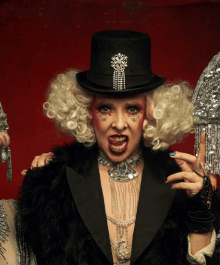

Le Pustra Dives into the Dark Legends of Weimar Berlin
By Victoria Linchong . February 22, 2017
His face is heavily painted like an early silent film star. Asta Nielsen perhaps, or Alla Nazimova. His hair is a cotton candy poof of lavender or garish red. Lounging in an impeccably tailored tuxedo, he takes a drag from an ebony cigarette holder and partially disappears in a shroud of smoke. A time-traveler, he hops between 1930, 1989, and the present day, no doubt changing genders depending on his mood, like a cuttlefish or a moray eel or like Virgina Woolf’s Orlando.
This is Le Pustra as I know him, but when we met, he was out of drag and had somehow metamorphosed into a small dark man in a leather jacket. The only thing about this shape-shifter that remained the same was his haunted eyes. Or maybe it was just that the sun was making a rare appearance in Berlin and I was rather blinded. Shifting from one seat to another to avoid the intense glare, we talked about his remarkable cabaret-theater piece, Kabarett der Namenlosen, which is making its third sold-out appearance in Berlin this weekend.
One of the things I’m struck by is that you’re influenced by so many things. Everything from Klaus Nomi and David Bowie to Commedia dell’ Arte to Weimar Berlin…
Right now I’m obsessed by the Marchesa Casati. She’s so inspirational because she was self-made. We live now in the age of the narcissist with Instagram and iPhones. We document ourselves and create ourselves. And she did that at the end of the 19th century. Without an iPhone. She’s an inspiration for someone I’d like to be. I don’t care if the legend is true or not: I want a dead snake that’s painted gold around my neck.
Did you come from an artistic family?
Not at all. I’m adopted and my family is completely working class, very average. No one went to university. I’m really the weird one in this family. And I don’t know if my biological mother is artistic. I’ve never met her. So it really is – how can I explain it? – it was just in me. You feel like you don’t fit. Also in the country – South Africa – now that I’m away, I miss a lot of it but when I was growing up, I knew I had to be in Europe. I just knew that whoever I wanted to become had to be there.
So how did you start your journey into such obscure and eclectic corners of the art world?
As far back as I remember, films were the main thing that gave me passion and ideas. The way I now put things together is images in my head; cinematic images like flashes. That’s how I think. Especially with this show. Cinema was from a very early age my way of escaping.
But you weren’t in film, were you? You were in theater.
I went to musical theater college in Capetown. It was very difficult the first year because I was so shy. It didn’t come naturally. So after the first year, I wanted to give up. And then I had a wonderful singing teacher who opened up this new world. She really gave me that support and that’s why I think motivating other artists is so important. Because we are so fragile and so sensitive and so neurotic. We’re constantly fighting with ourselves everyday. Later, I did take a film course in London, but it turned out I wasn’t very good in front of the camera. So live theater was something I didn’t think I wanted to pursue. But then I realized I can do this.
So you made your way from Capetown to London. And what brought you to Berlin?
I wanted a change. I’d been doing cabaret for many years and I just got to a point where I was bored. So I wanted to do a solo show in Paris but I couldn’t find an apartment. And then Lada Redstar said, “Just come live with me.” So I came to Berlin in 2012 with no plan. And we went on the Christopher Isherwood walking tour in Nollendorfplatz. A friend of mine does it, Brendan Nash. And he mentioned the Kabarett der Namenlosen and as soon as he said the name, I was like, wow, what is that? And then when I got home and googled it, I was a bit disappointed to find out it was this sort of X-Factor, this talent show. But I liked the title, so I created a sort of standard variety show and brought it to London. I did it like three times. And then left it because it was a sort of side project.
Some years later, I was contacted by the granddaughter of Erich ‘Elow’ Lowinsky, the guy who created the original Kabarett der Namenlosen. She found me on the internet and we met in London. At that time, I had no plans to move here or do the show again. But then I did move here and after a few months, I thought, why don’t I do the show here? I wanted to do something different though. I had this idea of this sort of surreal other world. I’ve done many ’20s nights and I always find them sort of boring. It’s just gangster and flapper nights.
Dress up.
Yeah, and that’s fine but I kind of wanted to have my fantasy of what the ’20s were like. Or what it could be. And I wanted something different from the regular set-up of a variety show with all these acts and nothing in between, no connection. Well, you might say that a lot of the performers are doing their own acts, but we’ve adapted it, we’ve developed it. So in terms of creativity, it’s something more than just being on stage for three minutes and then leaving. I think that’s what I got bored of. It wasn’t satisfying anymore. I wanted a show where the audience sits in this smoke bubble and they don’t know what is happening. And they go on this journey and when they come out, they feel they’ve been in the 1920s.
This is more of a theater piece. All of the characters have a story – a beginning, middle, and end. And they have a relationship as well.
And now for the next show even more so. There’s been more development on how everyone links in. The show has a very strong occult theme now that frames it from beginning to end. Valerie Renay from the electro-band Noblesse Oblige is portraying a spiritualist. And we decided to go with this whole Victorian look. Because that’s another thing I love, the morbidity of the Victorians. So when the show starts, she’s invoking these spirits and these names. We found an old Victorian incantation, mixed in with bits from Penny Dreadful, the TV show, so basically everything happens in the middle of flashbacks. Because the scenes don’t relate. They are literally like sliding ghosts. So here you see something happening and there you see something happening. And at the end, it suddenly concludes. It’s a bit of poignancy that many of these characters really did disappear in smoke. Because we all know what happens next. So many performers did disappear. There’s no documentation. They were just lost.
When I saw your show, it felt like you had picked open a badly healed wound. It feels like the Germans are still trying to figure out a way to talk about the 1930s and they’re only now starting to find something that was beautiful about that time.
I think one of the most interesting things is that this fascination over the ’20s is all from outsiders. Everyone who comes in from England and America…
Because for us, the legend of Berlin is the Weimar era.
We’re fascinated. Germans here are not. They’re not interested or they don’t know about it.
But I think the Germans who see the show realize that there’s a missing part. And I think you’re showing them that there was something beautiful about that time that they can embrace.
There is really nothing like the Kabarett der Namenlosen in this city. It’s taken on its own life because of the way people are reacting. So many people come here looking for Weimar cabaret; we even had people in September flying in to see the show. The BBC came in December and they filmed us. Somehow the show filtered through to them and they’re doing a documentary on the music of the 1920s. So we sang Das Lila Lied for them and it’s going to be part of the documentary, which is going to be amazing for the show. But again, it’s outsiders. It’s the British, the Americans. They love the 1920s. The Liza Minnelli version of it. Which is another thing I have to fight for because people just assume that’s what it is.
I read something about how in the 1970s when they started to work on Cabaret, they couldn’t find any material. So they basically had to make it up from hearsay and a few photographs.
So much was destroyed. All we have left of Weimar cabaret are flashes of images and photos in books. There’s no way to really know what it was like. What I wanted to tell was the freedom. It must have been so amazing to be gay and go into a club and you could dance with a man. So I wanted to bring the spirit of that back in a new contemporary way. Because the ’20s is something that has been done to death. When the press just says it’s a show about the ‘20s, I’m like ugh. You know what I mean?
Well, the Kabarett der Namenlosen is not just the ‘20s. It’s more like the license of the ’20s. We forget that the reason why the ’20s were so exciting was because everything about the world had just been decimated by World War I.
It was a release. Dancing came in. Women were cutting their hair. And even though gay sex was still illegal, censorship was relaxed. I mean, the country was so poor, in financial chaos. So I think it was more creative with film and fashion and all that.
But there was also a darkness. The gaiety was more desperation.
What people forget now is that there was so much poverty. Even middle class families lost all their money in World War I. And, when the country went bankrupt and with the hyperinflation, so many women became prostitutes. The poverty in Berlin at that time, we tend to not look at that. We only look at the glamorous part, but around it, there was so much poverty. And the glamour was very contained because only a few people had access to that. It wasn’t available to everyone.
The reason why the glamour was so heightened was because the darkness was also heightened.
This very stark contrast. It’s fascinating. And also because it was short-lived and ended so horribly, we tend to romanticize it. It’s like the Titanic.
We talked about all the ghosts in the Kabarett der Namenlosen. Of course, there’s references to Marlene Dietrich and Anita Berber but there’s also all these amazing characters.
So you have Charlie, who’s the sailor. In the ’20s, the sailor look was a way to show, oh, he’s gay. Because sailors were regarded as uber-masculine men who traveled around the world and they can have sex with anyone they want. And we have Mama Ulita, who’s sort of power lesbian, very chic. Then you have Lada Redstar. There was a lot of nude dancing going on. Anita Berber used to dance naked. But nudity in dance became all the rage. And then you have someone like Lars Schwuchow, who represents the voyeurs, or the aristocracy with his mask and his hat, this rich guy indulging in the sins of the flesh but he’s also prostituting himself as well. Everyone was available at a certain cost. There’s a lot of archetypes, people from this time.
The good thing about the show is that we can introduce all these characters. But I don’t want to do it in an obvious way. No one is named, “Oh, this is Anita Berber.” Bridge Markland’s interpretation is such a weird take on it. When she’s older or whatever. And if I’m going to sing the Dietrich song, I’m going to have purple hair. So it’s just fun to play with. Like arranging all your toys or all your dresses according to color.
Are there other changes in the script? Different characters?
Nope, Valerie is the only new cast member. There’s some new songs, little changes. But there’s much more development with the occult theme. The aim of the show is to have it as a theater piece. But a show like this wouldn’t work in the Wintergarten, because it would lose the intimacy and the underground feel of it.
So you’re thinking of touring?
I don’t want to think about that yet! But yes, we need to find some version that can tour. At the moment, there are too many people and it’s a bit much. It can’t just go from here to here. I mean, the whole show is built around the Ballhaus.
Would you consider the shows at the Ballhaus a sort of workshop production?
I don’t know. I’m just going from show to show. I’ll see how February goes and I’ll see what’s next after that. I mean, people could lose interest after that. You don’t know. But we’ll see how far we can take it. I mean we’ve got the gallery exhibition…
What’s the gallery exhibition?
Alana Richards is coming to paint the performers. We’re going to have an exhibition in a gallery called the Ballery on Nollendorfstraße. I’ve sung there a few times. It’s run by an English guy who used to be a ballet dancer and he’s open to new things. So we have this idea to have these portraits and drawings and sort of have a whole interactive thing with performances. But the focus is obviously the paintings. To immortalize these characters into art. Coming back to Marchesa, that’s like the ultimate way to preserve your legacy or your myth.
Kabarett der Namenlosen will be at Ballhaus Berlin from February 24-26. Tickets are sold out, but perhaps some early buyers will make a few available on the Facebook event page. More about Le Pustra is on his website. Hendrick’s Gin is a creative collaborator. The show is produced by Boheme Sauvage.






